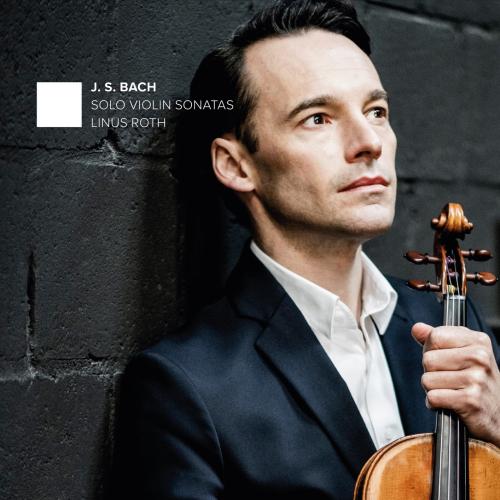
Bach: Solo Violin Sonatas Linus Roth
Album info
Album-Release:
2021
HRA-Release:
03.09.2021
Label: Evil Penguin Classic
Genre: Classical
Subgenre: Instrumental
Artist: Linus Roth
Composer: Johann Sebastian Bach (1685–1750)
Album including Album cover
- Johann Sebastian Bach (1685 - 1750): Violin Sonata No. 1 in G minor, BWV 1001:
- 1 Bach: Violin Sonata No. 1 in G minor, BWV 1001: I. Adagio 04:12
- 2 Bach: Violin Sonata No. 1 in G minor, BWV 1001: II. Fuga 05:45
- 3 Bach: Violin Sonata No. 1 in G minor, BWV 1001 : III. Siciliana 03:19
- 4 Bach: Violin Sonata No. 1 in G minor, BWV 1001: IV. Presto 03:44
- Violin Sonata No. 2 in A minor, BWV 1003:
- 5 Bach: Violin Sonata No. 2 in A minor, BWV 1003: I. Grave 04:28
- 6 Bach: Violin Sonata No. 2 in A minor, BWV 1003: II. Fuga 08:40
- 7 Bach: Violin Sonata No. 2 in A minor, BWV 1003 : III. Andante 06:13
- 8 Bach: Violin Sonata No. 2 in A minor, BWV 1003: IV. Allegro 06:45
- Violin Sonata No. 3 in C major, BWV 1005:
- 9 Bach: Violin Sonata No. 3 in C major, BWV 1005: I. Adagio 04:44
- 10 Bach: Violin Sonata No. 3 in C major, BWV 1005: II. Fuga 11:01
- 11 Bach: Violin Sonata No. 3 in C major, BWV 1005: III. Largo 03:25
- 12 Bach: Violin Sonata No. 3 in C major, BWV 1005: IV. Allegro assai 05:51
Info for Bach: Solo Violin Sonatas
The cycle of six solo Sonatas and Partitas by J.S. Bach is arguably one of the most powerful and most important compositions in musical history. These works have been with Linus Roth since he was nine years old, when he first learned the Gigue from the E major Partita, moving on by the age of twelve to the first Fugue in G minor to tackling at fifteen the Ciaconna, which represents a cosmos in its own right. By seventeen, Roth had finally learned the entire oeuvre for the first time and since then he is fortunate to have been able to grow as a musician through the constant and welcome challenge of interpreting these remarkable works.
Bach did not write ‘Six Solos’ on the cover of the score, but instead wrote ‘Sei Solo’ in Italian, which can have two meanings: the word ‘Sei‘ can be translated both as the number six and also as ‘You are’. ‘You are alone’ - Bach is unlikely to have left something so important to chance or to be playing a simple word game. This announcement – if it is even to be seen as a reminder from the composer to the performer - must be taken seriously and Linus has always viewed it as an invitation to interpret the music as freely as the musical text allows, which for him became a guiding principle in his quest for his own interpretation.
This recording was made during lockdown, in which all of our lives have had to be reduced to a minimum in almost every area. The chance to renew the intense preoccupation with this miraculous music in preparation for the recording was a huge privilege as it allowed Linus an escape into a spiritual freedom which helped him greatly on a personal level at this time.
Not only did Roth's teachers and the interpretations of great violinists have a huge influence on how he plays Bach, but also his preoccupation with the original text and with what is known as ‘historically informed performance practice’, in particular the experience of playing with the type of convex Baroque bow that was used in Bach’s time. Due to its bend and the different weight distribution, it has a different nature to the concave curved bow used today, which leads to a slight decrescendo phrasing where several notes are slurred together towards the tip of the bow. In Linus' opinion, the modern bow suits the modern violin better and enables a wider range of sounds, which is why he tries to translate these Baroque-style experiences to the modern bow.
While the slurs and other details in the musical text were not always adhered to in years gone by, further meticulous examinations of the text have resulted in music editions that faithfully reproduce all the details of Bach’s handwriting, yielding fascinating results.
Bach completed the Six Solo Sonatas and Partitas in 1720 in Koethen when he was appointed conductor of the court there. It was the only office he held in which he was not exclusively committed to ‘musica sacra’. Nevertheless, the three solo Sonatas follow the form of the so- called ‘Sonata da Chiesa’ or Church Sonata. They each consist of four movements in the order slow-fast-slower-fast/er. The first movement is a free prelude in improvisational character, followed by a four-voiced Fugue. The third movement is song-like and the fourth resembles a brilliant Toccata.
Linus Roth, violin
Linus Roth
ist nicht nur seit 2012 Professor für Violine am Leopold-Mozart-Zentrum der Universität Augsburg, er ist darüber hinaus auch seit Jahren eine feste Größe in der internationalen klassischen Musik. Wie für die meisten Berufsmusiker stellte auch für Roth das letzte Jahr eine Herausforderung dar, da viele seiner Konzerte und Engagements pandemiebedingt entfallen mussten. Der Violinist nutzte diese „Zwangspause“ aber kreativ und beschloss dafür ein Projekt umzusetzen, für das ihm zuvor die Zeit gefehlt hatte: Ein Aufnahmeprogramm mit Tanzmusik für Violine und Klavier. Dabei handelt es sich durchgehend um sog. virtuose Tänze, das heißt um solche Stücke, die hohe spieltechnische Anforderungen an den Interpreten stellen. Das Repertoire umfasst dabei Werke von Komponisten wie Béla Bartók, Johannes Brahms und Igor Stravinsky. Am Klavier begleitet wird Roth von seinem langjährigen musikalischen Weggefährten, dem argentinischen Pianisten José Gallardo.
Linus Roth begann seine Karriere bereits im Alter von zwölf Jahren in der Vorklasse von Prof. Nicolas Chumachenco in Freiburg. Danach absolvierte er ein mehrjähriges Musikstudium, unter anderem in Lübeck, Zürich und München. Nach seinem erfolgreichen Diplomabschluss als Solist folgten zahlreiche, auch internationale, Auftritte, sowie erste musikalische Veröffentlichungen. Für sein Debütalbum wurde er 2006 mit dem ECHO Klassik ausgezeichnet. 2012 wurde Linus Roth auf eine Professur für Violine am LMZ der Universität Augsburg berufen. 2019 übernahm er zudem die künstlerische Leitung des Internationalen Violinwettbewerbs Leopold Mozart.
Das Album „Virtuoso Dances“ erscheint am 5. März 2021 bei Evil Penguin Classics.
This album contains no booklet.













